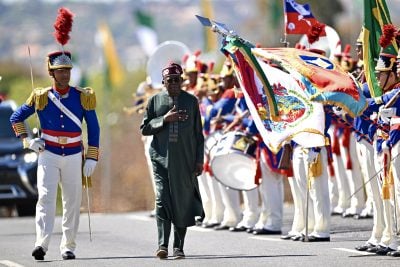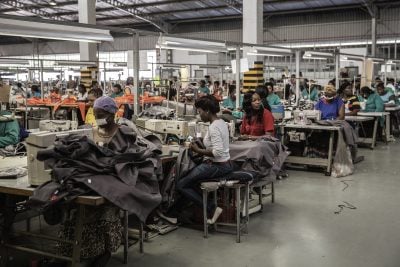Land set aside for the Jinfei Chinese special economic zone in Mauritius remains empty, almost a decade after it was announced to great fanfare.
On the west coast of Mauritius, between the colourful capital of Port Louis and the picturesque beaches in the north, there lies an expansive and unoccupied piece of land. Red, fertile earth with patches of wild grass stretch as far as the eye can see, interrupted only by shadowed mountains in the distance, the possible glimmer of the sea to the west and – if you are lucky enough to stumble across them – one or two huge buildings isolated for miles around.
Navigating around this area, however, is not difficult. Smooth tarmac roads, several wide lanes generously lined with street lamps crisscross all through this ghostly expanse.
On weekends, drag racers use these highways for illegal but well-attended contests of speed, while on weekdays learner drivers practise their clutch control and three-point turns away from the glare and blare of traffic.
It was all meant to be so different. In 2006 the government of the time announced that it had agreed to establish a special economic zone (SEZ) with the Chinese private company Tianli Spinning, a project that was intended to usher in the next era of Mauritius’ economy.
Mauritius always seemed a surprising location for such a zone, but the government pursued it relentlessly and eventually got its reward, promising the Mauritian people that it would all be worth it. Attracted by low taxes and a stable environment, it was proposed that Chinese businesses would flock to the zone, creating tens of thousands of jobs, and leading to the establishment of new lucrative sectors in the country’s slowing economy.
But construction stalled time and again. The companies never came. And so when a new Mauritian government came to power in December 2014, inheriting the failed promise of the Jinfei Economic and Trade Cooperation Zone, it understandably vowed to reinvigorate it − though how exactly, no one can quite say.
The story of the Jinfei project started at the third Forum on China-Africa Cooperation (FOCAC) in 2006, where then Chinese president Hu Jintao announced that China intended to establish three to five special economic zones in Africa over the coming years.
Based on China’s own developmental experiences at home, the projects were proposed as a potential win-win for both sides. Chinese companies willing to “go out” would gain closer access to markets, resources and cheap labour in a relatively low-risk environment, thanks to the provision of infrastructure in the zones and preferential regulation. Meanwhile,
African host countries would benefit from new waves of foreign investment, knowledge transfer and job creation.
The SEZ plan garnered significant interest from both African governments and Chinese businesses and several zones were proposed. Those eventually approved showed clear potential for the companies involved: Chambishi in Zambia, for example, promised access to vast quantities of natural resources; Ethiopia was attractive for its cheap labour and huge internal market; and Nigeria had plenty of both.
With its population of just 1.3m, no natural resources to exploit, and a society that was already having to import its own cheap labour, Mauritius seemed like the odd one out.
However, the Mauritian government eagerly pursued approval for the project, and in a meeting with Hu Jintao and Prime Minister Wen Jiabao, emphasised the country’s stability, rule of law, business-friendly environment, and preferential access to both African and Western markets.
Mauritius proposed that it could be natural gateway between Asia and Africa – a beautiful and accommodating stepping stone – and in the end, Beijing seemed to agree.
Under the deal, the Mauritian government agreed to lease 211 hectares of land in Riche Terre – a prime location close to the sea, the capital Port Louis and the Grand Baie tourist hub in the north – to the private Tianli Spinning for 99 years.
Although the deal was shrouded in secrecy, it was believed the zone could become a hub for light manufacturing, information and communication technology, and hi-tech industries – the kinds of upscale sectors Mauritius hoped to develop.
It was agreed that the government would be responsible for off-site infrastructure, while the Chinese company would be responsible for on-site developments, and a roadmap ahead was approved.
However, problems with what was then the Tianli Project started to manifest immediately. There were a few hundred planters operating in Riche Terre – which literally translates as ‘fertile land’ – and while some accepted compensation, a hundred or so refused the terms on offer.
On more than one occasion, the farmers went on hunger strike in a legal and political battle that went unresolved for several years. In the meantime, the 2007–8 global financial crisis hit, reducing Tianli’s ability to carry out the developments necessary and raising worries that it would be difficult to attract investors in the current climate.
In 2009, following a state visit to the island, Hu Jintao tried to rescue the project by instructing the Shanxi Provincial Government to take responsibility. In turn, Shanxi encouraged two massive resource companies – Taiyuan Iron and Steel Company (TISCO) and Shanxi Coking Coal Group – to become partners in the endeavour. Tianli became a minority partner.
The initiative was renamed the Jinfei Project, and its proposed use shifted towards real estate, hospitality centres and services. The newly rebranded zone was launched amidst great fanfare in September 2009 and the basic infrastructure was completed a year or two later. Yet still no investors turned up. The zone lay dormant for several years, and now, in 2015, one is still more likely to spot a goat grazing in one of the zone’s abandoned fields than a high-powered Chinese professional looking to do business.
Why did it falter?
In terms of Mauritius’ economic history, the Jinfei project may well have seemed like a good idea. Mauritius’ economic growth spurt in the 1980s and diversification away from a mono-crop economy had been premised on the establishment of export processing zones whose low-tax incentives and market access lured foreign investors in sectors such as textiles.
It was hoped the new SEZ would emulate that success story with higher end industries, creating 40,000 jobs and significant spill-over benefits to the economy.
But the conditions this time round seemed misplaced. Mauritius did not appear to be an attractive location for Chinese businesses, Beijing did not see it as a priority to be pursued at any cost, and some analysts believe the project may have been doomed for a variety of reasons.
“It was very badly negotiated from the very beginning and in contrast to the other SEZs in Africa, the Chinese companies involved in Jinfei had no experience in SEZ management, nor did they specialise in the sectors they were supposed to be developing,” says Honita Cowaloosur, a researcher who completed her PhD on the project.
“But you also have to ask yourself: why would any Chinese business person with a lot of money want to set up a manufacturing plant in Mauritius anyway? You can’t get cheap labour, you aren’t going to get any raw materials, you are not going to capture any market, and you’ll still have to sell your products somewhere on the continent. Why not go straight to the continent?”
It was likely due to these concerns that plans for the zone switched away from the kinds of industries that would have led to knowledge transfers to Mauritius, and towards the kinds of residential, cultural and service-based sectors in which the country already specialises.
The new plan, it seems, was to establish Mauritius as a kind of tranquil suburb of Africa where Chinese businesses could base themselves whilst operating on the mainland. But this did not seem to fit into China or Chinese companies’ way of doing business either.
“The Mauritian government had this idea that they would position themselves as a bridge between China and Africa,” says China-Africa expert
Deborah Brautigam.
“But the truth is that China and Africa just fly right over Mauritius. They don’t see any reason to stop there…
“They have had some nice ideas, such as setting up offshore Chinese schools in Mauritius for Chinese expatriates to send their children, but expats don’t really bring their children to Africa so there’s not really the demand for that kind of thing.”
Meanwhile, although Mauritius is a valued – though minor – partner of China, Brautigam believes that Beijing would not be overly concerned if Jinfei failed to bear fruit.
Some observers believe the placement of China’s SEZs across the continent is part of some longer-term purpose, which might mean the Mauritian SEZ has a special place in China’s future plans, but Brautigam is sceptical of this idea.
“Some people have tried to suggest the location of the zones across Africa is strategic, and that there’s deliberately one in each region but that’s not really the case,” she says.
“The overall SEZ idea is strategic, but not the locations of the ones selected.
“Nothing has really happened in Mauritius because the company that proposed it hasn’t been able to get it going, and the Chinese government hasn’t seen the need to push it.
Mauritius has some diplomatic importance to China, but if it had some bigger strategic importance, China would have done more.”
With Beijing sitting back, the zone struggling to be commercially attractive investors, and the Mauritian government lacking the capacity to kick-start the project, it is perhaps not surprising that most people have started to forget it even exists.
“In Mauritius, nobody really cares about Jinfei any more, to be honest,” says Cowaloosur.
“A good number of Chinese companies do come and settle in Mauritius – fortunately the failure of the zone hasn’t affected broader China-Mauritius relations – but they settle outside the zone.”
The future of the zone
Some frustrated observers may have hoped that the petering out of the Jinfei project would be the end of the story. But the fact that 211 hectares of prime land in one of the world’s most densely populated countries was awarded to Chinese developers for a massive 99 years puts the Mauritian government in a difficult position. Indeed, while promising to better compensate the displaced planters – who have continued to suffer – the new government that came to power in December 2014 has already said that it cannot give them back their land.
Instead, it seems that the new administration is holding out hope that the mega-project can be made to work and is looking to inject new life into the project by renegotiating the terms of the deal. It has reportedly begun talks with the Chinese companies involved, calling for the project to be restructured as a joint venture in which the government owns 80% of the shares.
What it plans to do beyond that, however, remains to be seen. It could try to revive one of the earlier plans of developing higher-end industries or of becoming a services hub; it might reduce the Chinese essence of the zone and court foreign investors from elsewhere; or it might do something completely different, such as look to establishing it as a base for renewable energies or Chinese deep-sea exploration. The future, as ever with Jinfei, is uncertain.
In 2006, backed by Beijing, Chinese companies were encouraged to look across Africa and propose special economic zones as potential bases of industry, extraction and manufacturing. Several were proposed and, in the end, SEZs were approved in Nigeria, Zambia, Ethiopia, Algeria, Egypt and Mauritius.
Some of these have since flourished, but from the start, the tiny island of Mauritius, located over 2,000km off the African mainland, stuck out like a sore thumb from this list of African powers. And nearly a decade later, Mauritius still stands out. While Chinese companies have been ramping up operations in SEZs across the continent, the Jinfei zone sits silent, its expansive unoccupied roads acting as a metaphor for the fate of the entire project up till now − from nowhere, going nowhere.
James Wan
Want to continue reading? Subscribe today.
You've read all your free articles for this month! Subscribe now to enjoy full access to our content.
Digital Monthly
£8.00 / month
Receive full unlimited access to our articles, opinions, podcasts and more.
Digital Yearly
£70.00 / year
Our best value offer - save £26 and gain access to all of our digital content for an entire year!
 Sign in with Google
Sign in with Google 


